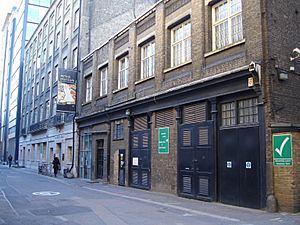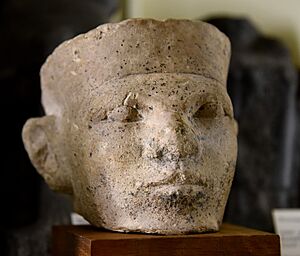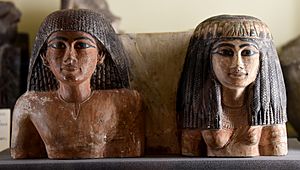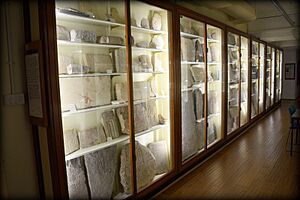Petrie Museum of Egyptian Archaeology facts for kids

The Petrie Museum of Egyptian and Sudanese Archaeology
|
|
| Established | 1892 |
|---|---|
| Location | London |
| Collection size | Over 80,000 objects |
The Petrie Museum of Egyptian and Sudanese Archaeology in London is a super cool place! It's part of the University College London Museums and Collections. This museum holds over 80,000 ancient objects. That makes it one of the biggest collections of Egyptian and Sudanese history in the whole world! It's so important that the Arts Council England says it has "national and international importance."
Contents
Discovering Ancient Egypt: The Petrie Museum's Story
The museum started way back in 1892. It was created to help students learn about ancient Egypt at University College. A writer named Amelia Edwards gave the first collection of artifacts.
William Matthew Flinders Petrie: A Famous Explorer
A very important person named William Matthew Flinders Petrie became the first professor. He was like a real-life Indiana Jones! Petrie led many exciting digs in Egypt. In 1913, he sold his huge collection of Egyptian treasures to University College. This made the museum's collection truly amazing. It became one of the best outside of Egypt itself.
The collection first opened for people to see in 1915. Petrie explored many famous places. He found beautiful mummy portraits at Hawara. He also dug up Amarna, the city of King Akhenaten. And he explored the first true pyramid at Meydum. There, he found some of the earliest clues about how mummies were made.
The Museum's Journey Through Time
At first, only students and teachers could visit the museum. It wasn't open to everyone. Petrie retired in 1933, but other explorers kept adding to the collections. They found more treasures in Egypt and Sudan.
During Second World War (1939–1945), the museum's treasures had to be moved. They were packed up and taken out of London to keep them safe. In the 1950s, the collection moved into an old stable building. That's where you can still find it today! It's right next to the UCL Science Library.
Visiting the Petrie Museum Today
The Petrie Museum is located at Malet Place in London. It's close to Gower Street. The best part? Admission is completely free! The museum often has special events and exhibitions. These are fun for both kids and adults. There's even a special group called "Friends of the Petrie Museum" that helps support it.
Exploring the Museum's Amazing Collections
The museum's entrance area was updated in 2019 and reopened in 2020. It tells you all about the museum's history. You can learn about important people like Petrie and Amelia Edwards. There's also a small gift shop where you can find cool souvenirs.
The museum has three main areas to explore. The biggest area is above the old stables. Here, you'll find many small everyday objects and beautiful mummy portraits. There's also the Inscriptions Aisle. This aisle shows ancient tablets with writing. You can see hieroglyphics, Greek, and Arabic writing.
Another area is the pottery gallery. It's filled with cabinets of ancient pottery, clothing, and jewelry. You'll also see shabti figures, which were like servants for the afterlife. Everything is arranged in order from oldest to newest.
You can even look at the entire collection online! All the objects have been photographed and described.
Special Treasures You Can See

With over 80,000 objects, the Petrie Museum has many unique items. It's recognized as a collection of national and international importance.
- Ancient Clothes: The museum has some of the oldest clothes ever found! This includes a piece of Egyptian linen from about 5000 BC. It also has the Tarkhan dress from around 3000 BC. This is the oldest woven garment known in the world!
- Roman Egypt: You can see items from when the Romans ruled Egypt. This includes Britain's largest collection of Roman mummy portraits. These are realistic paintings of people's faces found on mummies.
- Historical Records: The museum also keeps important old papers. These include notes and photos from Flinders Petrie's digs. They also have records of how artifacts were shared with museums around the world.
Museum Leaders: Curators of the Past
A curator is like a guardian of the museum's treasures. They help take care of the objects and organize exhibitions. Here are some of the people who have been curators at the Petrie Museum:
- 1948–1963: Anthony J. Arkell
- 1963–1970: Harry Smith
- 1970–1978: David M. Dixon
- 1984–2001: Barbara Adams
- 1999-2013: Stephen Quirke
- 2013–2016: Alice Stevenson
- 2017–present: Anna E. Garnett
Books About the Museum
Many books have been written about the Petrie Museum and its collections.
- In 2007, a book called Living Images: Egyptian Funerary Portraits in the Petrie Museum was published. It's all about the Roman mummy portraits and how they are preserved.
- In 2015, UCL Press released The Petrie Museum of Egyptian Archaeology: Characters and Collections. This book has many articles about the museum's history and its amazing objects. You can even download it for free online!
See also
 In Spanish: Museo Petrie para niños
In Spanish: Museo Petrie para niños
- List of museums of Egyptian antiquities



